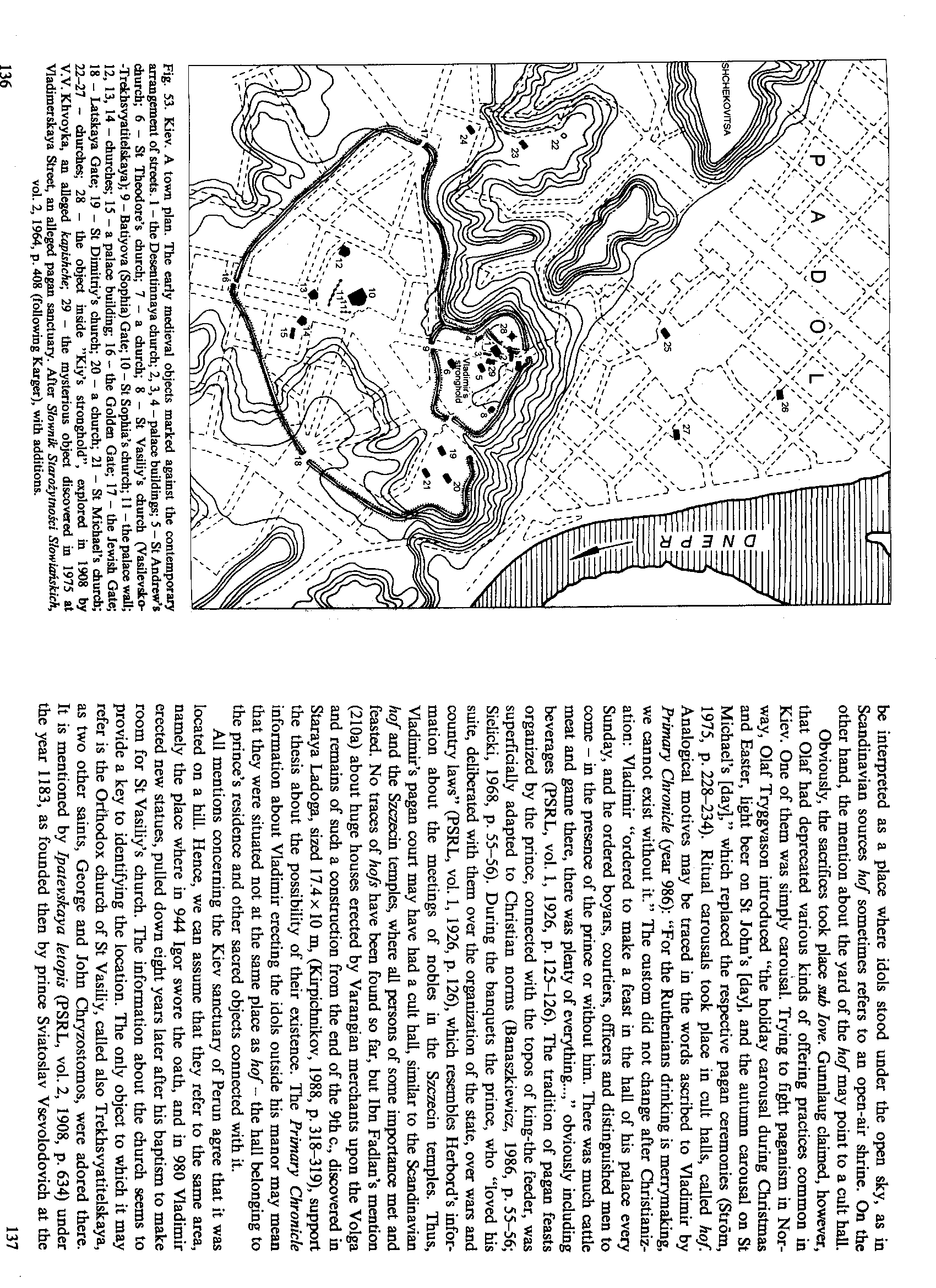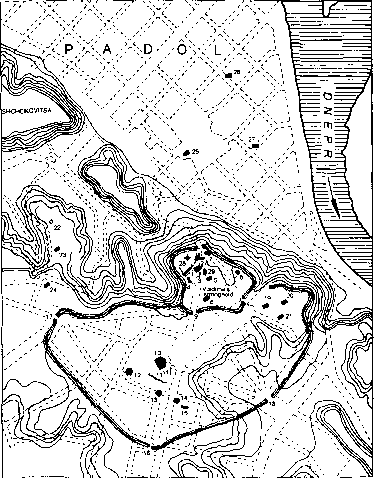image067


Fig. 53. Kiev. A town plan. The early medieval objects marked against the contemporary arrangement of streets. 1 - the Desentinnaya church; 2, 3, 4 - pałace buildings; 5 - St Andrews church; 6 - St Theodore’s church; 7 - a church; 8 - St Vasiliy’s church (Vasilevsko--Trekhsvyatitelskaya); 9 - Batiyova (Sophia) Gate; 10 - St Sophia’s church; 11 - the pałace wali; 12, 13, 14 - churches; 15 - a pałace building; 16 - the Golden Gate; 17 - the Jewish Gate; 18 - Latskaya Gate; 19 - St Diraitriy’s church; 20 - a church; 21 - St MichaeTs church; 22-27 - churches; 28 - the object inside ”Kiy’s stronghold”, explored in 1908 by V.V. Khvoyka, an alleged kapishche\ 29 - the mysterious object discovered in 1975 at Madimerskaya Street, an alleged pagan sanctuary. After Słownik Starożytności Słowiańskich, vol. 2, 1964, p. 408 (following Karger), with additions.
be interpreted as a place where idols stood under the open sky, as in Scandinavian sources hof sometimes refers to an open-air shrine. On the other hand, the mention about the yard of the hof may point to a cult hall.
Obviously, the sacrifices took place sub Iove. Gunnlaug claimed, however, that Olaf had deprecated various kinds of offering practices common in Kiev. One of them was simply carousal. Trying to fight paganism in Nor-way, Olaf Tryggvason introduced “the holiday carousal during Christmas and Easter, light beer on St John’s [day], and the autumn carousal on St MichaeFs [day],” which replaced the respective pagan ceremonies (Stróm, 1975, p. 228-234). Ritual carousals took place in cult halls, called hof. Analogical motives may be traced in the words ascribed to Vladimir by Primary Chronicie (year 986): “For the Ruthenians drinking is merrymaking, we cannot exist without it.” The custom did not change after Christianiz-ation: Vladimir “ordered to make a feast in the hall of his pałace every Sunday, and he ordered boyars, courtiers, offlcers and distinguished men to come - in the presence of the prince or without him. There was much cattle meat and gamę there, there was plenty of everything...,” obviously including beverages (PSRL, vol. 1, 1926, p. 125-126). The tradition of pagan feasts organized by the prince, connected with the topos of king-the feeder, was superficially adapted to Christian norms (Banaszkiewicz, 1986, p. 55-56; Sielicki, 1968, p. 55—56). During the banąuets the prince, who “loved his suitę, deliberated with them over the organization of the State, over wars and country laws” (PSRL, vol. 1, 1926, p. 126), which resembles Herbord’s infor-mation about the meetings of nobles in the Szczecin temples. Thus, Vladimir’s pagan court may have had a cult hall, similar to the Scandinavian hof and the Szczecin temples, where all persons of some importance met and feasted. No traces of hofs have been found so far, but Ibn Fadlau’s mention (210a) about huge houses erected by Varangian merchants upon the Volga and remains of such a construction from the end of the 9th c., discovered in Staraya Ladoga, sized 17.4 x 10 m, (Kirpichnikov, 1988, p. 318-319), support the thesis about the possibiłity of their existence. The Primary Chronicie information about Vladimir erecting the idols outside his manor may mean that they were situated not at the same place as hof - the hall belonging to the prince’s residence and other sacred objects connected with it.
All mentions concerning the Kiev sanctuary of Perun agree that it was located on a hill. Hence, we can assume that they refer to the same area, namely the place where in 944 Igor swore the oath, and in 980 Vladimir erected new statues, pulled down eight years later after his baptism to make room for StVasiliy’s church. The information about the church seems to provide a key to identifying the location. The only object to which it may refer is the Orthodox church of St Vasiliy, called also Trekhsvyatitelskaya, as two other saints, George and John Chryzostomos, were adored there. It is mentioned by Ipatevskaya letopis (PSRL, vol. 2, 1908, p. 634) under the year 1183, as founded then by prince Sviatoslav Vsevolodovich at the
137
Wyszukiwarka
Podobne podstrony:
image023 Fig. 15. Korzenica-Garz. I, II, m - the alleged traces of temples in the stronghold; after
image063 Fig. 47. Trzebiatów. A plan of the town and its surroundings. A - the cult place on David H
image008 Fig. 4. Possible reconstructions of the tempie in Old Uppsala, drawings based cm: A.-C. Sch
image017 Fig. 10. The plan of the stronghold m Arcona reconstructed by H.Berlekamp and J.Herrmann. A
image038 Fig. 17. Szczecin. The town arrangement in the earlier MiddJe Ages. 1 - the stronghold at t
image042 Fig. 18. The topography of the early-raedjevaj Wolin. A - the presumed location of the temp
image045 Fig. 21. Wolgast - a plan from about 1760 (a siraplified copy). The stronghold and St Peter
image049 1 m Fig. 26. The profile and plan of the remains of Ihe south-ea&tem wali base of the t
image056 Fig. 40. Stara Kourim. A large hall building. A - a plan; B - a profile of the wali constru
image077 Fig. 64. Gniloy Kut near Grodek Podolsky. A plan and profile of ”the cult yard” or altar. 1
image078 Fig. 66. The sanctuary in Rzhavintse. Top: a plan of the stronghold with sounding excavatio
image038 a Fig 10 Idea of the “World tree" as the “World axis" implemented m settlements o
Plan Praag OLD TOWN r - The Old Town Hall 2 The Street of Shifńng Signs } - The CitadelNOB
image083 Fig. 67. The enthroning ceremony of a Carinthian prince on an engraving from Osłerreichisch
image089 Fig- 71. The stoi»e walls around the peak of Góra Dobrzeszowska. 1 - the internal wali; 2 -
image090 Fig. 73. The alleged sanctuary on Bogit mountain. The stronghold. The cult circle. The alle
image093 fonner explanation, but notes also the latter one. The founding of the town is preceded by
image094 Fig. 75. The Krak Mound near Cracow. Photo L. Słupecki. is banished, and as the małe linę i
więcej podobnych podstron